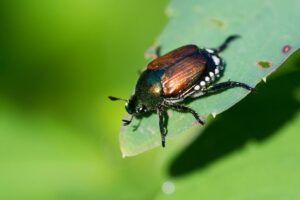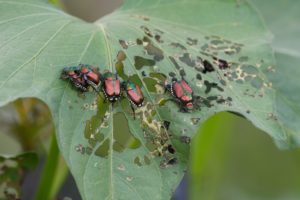JAPANESE
About This Invasive Species
 The Japanese beetle (Popillia japonica) was first discovered in southern New Jersey in 1916. Since then, these beetles have spread to every state east of the Mississippi River, except Florida. Adult Japanese beetles are slightly less than 1/2 inch long, with shiny, metallic green bodies and coppery-brown wing covers.
The Japanese beetle (Popillia japonica) was first discovered in southern New Jersey in 1916. Since then, these beetles have spread to every state east of the Mississippi River, except Florida. Adult Japanese beetles are slightly less than 1/2 inch long, with shiny, metallic green bodies and coppery-brown wing covers.
Japanese beetles on trees cause significant concern in arboriculture because they feed on the foliage of more than 350 plant species. Commonly affected trees include Norway and Japanese maple, birch, crabapple, plum, rose, mountain ash, and linden.
If you’re experiencing an infestation, schedule a consultation today to avoid more damage to your trees and yard as a whole.
Japanese Beetle Treatment
Japanese beetle damage can significantly harm your trees and plants. These pests feed on the soft tissue between the leaf veins, leaving behind skeletonized leaves. This type of damage weakens the plant, making it more vulnerable to other threats.
While Japanese beetle traps are often used to manage infestations, they can attract more beetles to your yard, potentially worsening the problem. Instead of using traps, we recommend seeking professional treatment from Eco Tree Company. Our certified arborists provide a thorough inspection and use targeted treatments to protect your plants effectively.
If you suspect your tree is has damage from these pests, please call us immediately at (608) 886-0626.
 To prevent damage, we also offer a natural, full-spectrum fertilizer and soil builder that strengthens your plants’ defenses. If an active infestation is found, we deploy our effective chemical treatments. After treatment, we prescribe a natural immune booster to aid in the recovery of your trees!
To prevent damage, we also offer a natural, full-spectrum fertilizer and soil builder that strengthens your plants’ defenses. If an active infestation is found, we deploy our effective chemical treatments. After treatment, we prescribe a natural immune booster to aid in the recovery of your trees!
